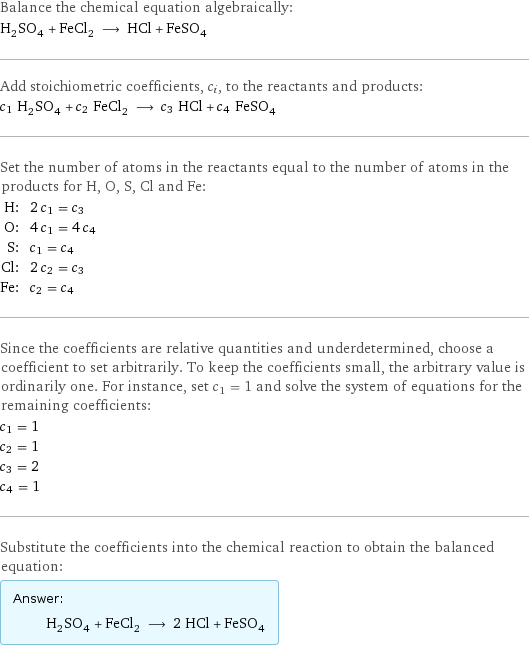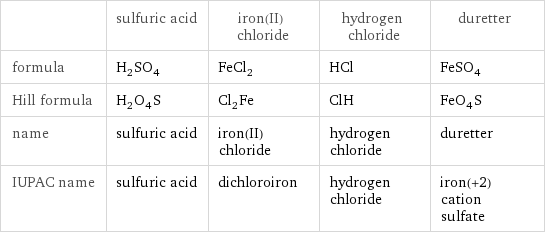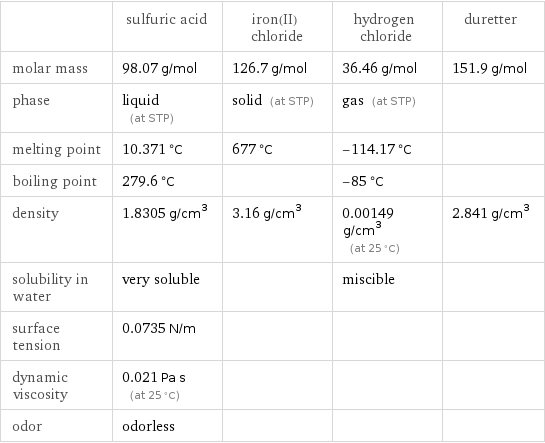Input interpretation

H_2SO_4 sulfuric acid + FeCl_2 iron(II) chloride ⟶ HCl hydrogen chloride + FeSO_4 duretter
Balanced equation

Balance the chemical equation algebraically: H_2SO_4 + FeCl_2 ⟶ HCl + FeSO_4 Add stoichiometric coefficients, c_i, to the reactants and products: c_1 H_2SO_4 + c_2 FeCl_2 ⟶ c_3 HCl + c_4 FeSO_4 Set the number of atoms in the reactants equal to the number of atoms in the products for H, O, S, Cl and Fe: H: | 2 c_1 = c_3 O: | 4 c_1 = 4 c_4 S: | c_1 = c_4 Cl: | 2 c_2 = c_3 Fe: | c_2 = c_4 Since the coefficients are relative quantities and underdetermined, choose a coefficient to set arbitrarily. To keep the coefficients small, the arbitrary value is ordinarily one. For instance, set c_1 = 1 and solve the system of equations for the remaining coefficients: c_1 = 1 c_2 = 1 c_3 = 2 c_4 = 1 Substitute the coefficients into the chemical reaction to obtain the balanced equation: Answer: | | H_2SO_4 + FeCl_2 ⟶ 2 HCl + FeSO_4
Structures

+ ⟶ +
Names

sulfuric acid + iron(II) chloride ⟶ hydrogen chloride + duretter
Equilibrium constant
![Construct the equilibrium constant, K, expression for: H_2SO_4 + FeCl_2 ⟶ HCl + FeSO_4 Plan: • Balance the chemical equation. • Determine the stoichiometric numbers. • Assemble the activity expression for each chemical species. • Use the activity expressions to build the equilibrium constant expression. Write the balanced chemical equation: H_2SO_4 + FeCl_2 ⟶ 2 HCl + FeSO_4 Assign stoichiometric numbers, ν_i, using the stoichiometric coefficients, c_i, from the balanced chemical equation in the following manner: ν_i = -c_i for reactants and ν_i = c_i for products: chemical species | c_i | ν_i H_2SO_4 | 1 | -1 FeCl_2 | 1 | -1 HCl | 2 | 2 FeSO_4 | 1 | 1 Assemble the activity expressions accounting for the state of matter and ν_i: chemical species | c_i | ν_i | activity expression H_2SO_4 | 1 | -1 | ([H2SO4])^(-1) FeCl_2 | 1 | -1 | ([FeCl2])^(-1) HCl | 2 | 2 | ([HCl])^2 FeSO_4 | 1 | 1 | [FeSO4] The equilibrium constant symbol in the concentration basis is: K_c Mulitply the activity expressions to arrive at the K_c expression: Answer: | | K_c = ([H2SO4])^(-1) ([FeCl2])^(-1) ([HCl])^2 [FeSO4] = (([HCl])^2 [FeSO4])/([H2SO4] [FeCl2])](../image_source/e1d634d1159a83662977b4314074759d.png)
Construct the equilibrium constant, K, expression for: H_2SO_4 + FeCl_2 ⟶ HCl + FeSO_4 Plan: • Balance the chemical equation. • Determine the stoichiometric numbers. • Assemble the activity expression for each chemical species. • Use the activity expressions to build the equilibrium constant expression. Write the balanced chemical equation: H_2SO_4 + FeCl_2 ⟶ 2 HCl + FeSO_4 Assign stoichiometric numbers, ν_i, using the stoichiometric coefficients, c_i, from the balanced chemical equation in the following manner: ν_i = -c_i for reactants and ν_i = c_i for products: chemical species | c_i | ν_i H_2SO_4 | 1 | -1 FeCl_2 | 1 | -1 HCl | 2 | 2 FeSO_4 | 1 | 1 Assemble the activity expressions accounting for the state of matter and ν_i: chemical species | c_i | ν_i | activity expression H_2SO_4 | 1 | -1 | ([H2SO4])^(-1) FeCl_2 | 1 | -1 | ([FeCl2])^(-1) HCl | 2 | 2 | ([HCl])^2 FeSO_4 | 1 | 1 | [FeSO4] The equilibrium constant symbol in the concentration basis is: K_c Mulitply the activity expressions to arrive at the K_c expression: Answer: | | K_c = ([H2SO4])^(-1) ([FeCl2])^(-1) ([HCl])^2 [FeSO4] = (([HCl])^2 [FeSO4])/([H2SO4] [FeCl2])
Rate of reaction
![Construct the rate of reaction expression for: H_2SO_4 + FeCl_2 ⟶ HCl + FeSO_4 Plan: • Balance the chemical equation. • Determine the stoichiometric numbers. • Assemble the rate term for each chemical species. • Write the rate of reaction expression. Write the balanced chemical equation: H_2SO_4 + FeCl_2 ⟶ 2 HCl + FeSO_4 Assign stoichiometric numbers, ν_i, using the stoichiometric coefficients, c_i, from the balanced chemical equation in the following manner: ν_i = -c_i for reactants and ν_i = c_i for products: chemical species | c_i | ν_i H_2SO_4 | 1 | -1 FeCl_2 | 1 | -1 HCl | 2 | 2 FeSO_4 | 1 | 1 The rate term for each chemical species, B_i, is 1/ν_i(Δ[B_i])/(Δt) where [B_i] is the amount concentration and t is time: chemical species | c_i | ν_i | rate term H_2SO_4 | 1 | -1 | -(Δ[H2SO4])/(Δt) FeCl_2 | 1 | -1 | -(Δ[FeCl2])/(Δt) HCl | 2 | 2 | 1/2 (Δ[HCl])/(Δt) FeSO_4 | 1 | 1 | (Δ[FeSO4])/(Δt) (for infinitesimal rate of change, replace Δ with d) Set the rate terms equal to each other to arrive at the rate expression: Answer: | | rate = -(Δ[H2SO4])/(Δt) = -(Δ[FeCl2])/(Δt) = 1/2 (Δ[HCl])/(Δt) = (Δ[FeSO4])/(Δt) (assuming constant volume and no accumulation of intermediates or side products)](../image_source/f9f002066eadf252e8bc7c445416911b.png)
Construct the rate of reaction expression for: H_2SO_4 + FeCl_2 ⟶ HCl + FeSO_4 Plan: • Balance the chemical equation. • Determine the stoichiometric numbers. • Assemble the rate term for each chemical species. • Write the rate of reaction expression. Write the balanced chemical equation: H_2SO_4 + FeCl_2 ⟶ 2 HCl + FeSO_4 Assign stoichiometric numbers, ν_i, using the stoichiometric coefficients, c_i, from the balanced chemical equation in the following manner: ν_i = -c_i for reactants and ν_i = c_i for products: chemical species | c_i | ν_i H_2SO_4 | 1 | -1 FeCl_2 | 1 | -1 HCl | 2 | 2 FeSO_4 | 1 | 1 The rate term for each chemical species, B_i, is 1/ν_i(Δ[B_i])/(Δt) where [B_i] is the amount concentration and t is time: chemical species | c_i | ν_i | rate term H_2SO_4 | 1 | -1 | -(Δ[H2SO4])/(Δt) FeCl_2 | 1 | -1 | -(Δ[FeCl2])/(Δt) HCl | 2 | 2 | 1/2 (Δ[HCl])/(Δt) FeSO_4 | 1 | 1 | (Δ[FeSO4])/(Δt) (for infinitesimal rate of change, replace Δ with d) Set the rate terms equal to each other to arrive at the rate expression: Answer: | | rate = -(Δ[H2SO4])/(Δt) = -(Δ[FeCl2])/(Δt) = 1/2 (Δ[HCl])/(Δt) = (Δ[FeSO4])/(Δt) (assuming constant volume and no accumulation of intermediates or side products)
Chemical names and formulas

| sulfuric acid | iron(II) chloride | hydrogen chloride | duretter formula | H_2SO_4 | FeCl_2 | HCl | FeSO_4 Hill formula | H_2O_4S | Cl_2Fe | ClH | FeO_4S name | sulfuric acid | iron(II) chloride | hydrogen chloride | duretter IUPAC name | sulfuric acid | dichloroiron | hydrogen chloride | iron(+2) cation sulfate
Substance properties

| sulfuric acid | iron(II) chloride | hydrogen chloride | duretter molar mass | 98.07 g/mol | 126.7 g/mol | 36.46 g/mol | 151.9 g/mol phase | liquid (at STP) | solid (at STP) | gas (at STP) | melting point | 10.371 °C | 677 °C | -114.17 °C | boiling point | 279.6 °C | | -85 °C | density | 1.8305 g/cm^3 | 3.16 g/cm^3 | 0.00149 g/cm^3 (at 25 °C) | 2.841 g/cm^3 solubility in water | very soluble | | miscible | surface tension | 0.0735 N/m | | | dynamic viscosity | 0.021 Pa s (at 25 °C) | | | odor | odorless | | |
Units
